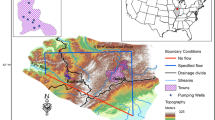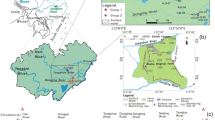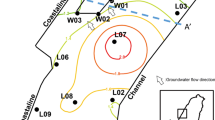Abstract
Natural analogues are an important source of long-term data and may be viewed as naturally occurring experiments that often include processes, phenomena, and scenarios that are important to nuclear waste disposal safety assessment studies. The Koongarra uranium deposit in the Alligator Rivers region of Australia is one of the best-studied natural analogue sites. The deposit has been subjected to chemical weathering over several million years, during which many climatological, hydrological, and geological changes have taken place, resulting in the mobilization and spreading of uranium. Secondary uranium mineralization and dispersed uranium are present from the surface down to the base of the weathering zone, some 25 m deep. In this work, a simple uranium transport model is presented and sensitivity analyses are conducted for key model parameters. Analyses of field and laboratory data show that three layers can be distinguished in the Koongarra area: (1) a top layer that is fully weathered, (2) an intermediate layer that is partially weathered (the weathering zone), and (3) a lower layer that is unweathered. The weathering zone has been moving downward as the weathering process proceeds. Groundwater velocities are found to be largest in the weathering zone. Transport of uranium is believed to take place primarily in this zone. It appears that changes in the direction of groundwater flow have not had a significant effect on the uranium dispersion pattern. The solid-phase uranium data show that the uranium concentration does not significantly change with depth within the fully weathered zone. This implies that uranium transport has stopped in these layers. A two-dimensional vertically integrated model for transport of uranium in the weathering zone has been developed. Simulations with a velocity field constant in time and space have been carried out, taking into account the downward movement of this zone and the dissolution of uranium in the orebody. The latter has been modelled by a nonequilibrium relationship. In these simulations, pseudo-steady state uranium distributions are computed. The main conclusion drawn from this study is that the movement of the weathering zone and the nonequilibrium dissolution of uranium in the orebody play an important role in the transport of uranium. Despite the fact that the model is a gross simplification of what has actually happened in the past two million years, a reasonable fit of calculated and observed uranium distributions was obtained with acceptable values for the model parameters.
Similar content being viewed by others
REFERENCES
Airey, P. L., 1986, Radionuclide migration around uranium ore bodies in the Alligator Rivers Region of the Northern Territory of Australia—Analogue of radioactive waste repositories—A review: Chem. Geology, v. 55, p. 255–268.
Bear, J., 1979, Hydraulics of groundwater: McGraw-Hill, New York, 234 p.
Davis, S. N., Marley, R. D., and Norris, J. R., 1992, Hydrogeological field studies: Alligator Rivers Analogue Project Final Report, Volume 5, Australian Nuclear Science and Technology Organisation (ANSTO), 174 p.
Duerden, P., 1992, The Alligator Rivers Natural Analogue Project: The International INTRAVAL Project, Phase 1, Test case 8, Organisation for Economic Co-operation and Development (OECD)/Nuclear Energy Agency (NEA), 215 p.
Edis, R., Cao, L. Q., Cashion, J., Klessa, D., Koppi, A. J., Murakami, T., Nightingale, T., Payne, T., Snelling, A., and Yanase, N., 1992, Chemistry and mineralogy of rocks and soil: Alligator Rivers Analogue Project Final Report, Volume 8, Australian Nuclear Science and Technology Organisation (ANSTO), 255 p.
Emerson, D.W., Mills, K. J., Miyakawa, K., Hallett, M. S., Cao, L. Q., 1992, Geophysics, petrophysics and structure: Alligator Rivers Analogue Project Final Report, Volume 4, Australian Nuclear Science and technology Organisation (ANSTO), 125 p.
Gray, W. G., Leijnse, A., Kolar, R. L., and Blain, C. A., 1993, Mathematical tools for changing spatial scales in the analysis of physical systems. CRC Press, Boca Raton, FL, 232 p.
International Atomic Energy Agency, 1981, Safety assessment for the underground disposal of radioactive wastes: Int. Atomic Energy Agency, Rep. 56, Vienna, 32 p.
Murakami, T., Isobe, H., Ohnuki, T., Yanase, N., Sato, T., Kimura, H., Sekine, K., Edis, R., Koppi, A. J., Klessa, D. A., Conoley, C., Nagano, T., Nakashima, S., and Ewing, R. C., 1992, Weathering and its effects on uranium redistribution: Alligator Rivers Analogue Project Final Report, Volume 9, Australian Nuclear Science and Technology Organisation (ANSTO), 138 p.
OECD/NEA, 1994, The International Alligator Rivers Project—Background and results: Organisation for Economic Co-operation and Development (OECD), Paris, 66 p.
Payne, T. E., Edis, R., Herczeg, A. L., Sekine, K., Seo, T., Waite, T. D., and Yanase, N., 1992, Groundwater chemistry: Alligator Rivers Analogue Project Final Report, Volume 7, Australian Nuclear Science and Technology Organisation (ANSTO), 185 p.
Pedersen, C. P., 1987, The geology of the Koongarra deposits, including investigations of contained elements, in Koongarra Project Draft Environmental Impact Statement, Appendix 5: Noranda Australia Limited, Melbourne, 97 p.
Snelling, A. A., 1990, Geological Development of the Koongarra uranium Deposit, in Alligator Rivers Analogue Project Progress Report September- November 1990: Australian Nuclear Science and Technology Organisation (ANSTO), p. 7–44.
Snelling, A. A., 1992, Geological Setting: Alligator Rivers Analogue Project Final Report, Volume 2, Australian Nuclear Science and Technology Organisation (ANSTO), 118 p.
Sverjensky, D. A., 1992, Geochemical modelling of present-day groundwaters: Alligator Rivers Analogue Project Final Report, Volume 12, Australian Nuclear Science and Technology Organisation (ANSTO), 70 p.
Townley, L. R., and Barr, A. D., 1992, Two-dimensional regional groundwater flow near Koongarra, in: ARAP 3rd Annual Report 1990- 1991, Australian Nuclear Science and Technology Organisation (ANSTO), p. 165–193.
Townley, L. R., Barr, A. D., Braumiller, S., Kawanishi, M., Lever, D. A., Miyakawa, K., Morris, S. T., Raffensberger, J. P., Smoot, J. L., Tanaka, Y., and Trefry, M. G., 1992, Hydrogeological Modelling: Alligator Rivers Analogue Project Final Report,Volume 6, Australian Nuclear Science and Technology Organisation (ANSTO), 133 p.
van de Weerd, H., Leijnse, A., Hassanizadeh, S. M., and Richardson-van der Poel, M. A., 1994, INTRAVAL Phase 2, Test case 8, Alligator Rivers Natural Analogue—Modelling of uranium transport in the weathered zone at Koongarra (Australia): RIVM Report 715206005, Bilthoven, The Netherlands, 77 p.
Wyrwoll, K.-H., 1992, Geomorphology and paleoclimatic history: Alligator Rivers Analogue Project Final Report, Volume 3, Australian Nuclear Science and Technology Organisation (ANSTO), 93 p.
Author information
Authors and Affiliations
Rights and permissions
About this article
Cite this article
Leijnse, A., van de Weerd, H. & Hassanizadeh, S.M. Modeling Uranium Transport in Koongarra, Australia: The Effect of a Moving Weathering Zone. Mathematical Geology 33, 1–29 (2001). https://doi.org/10.1023/A:1007554008927
Issue Date:
DOI: https://doi.org/10.1023/A:1007554008927




